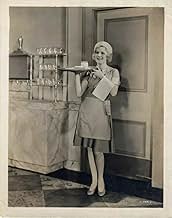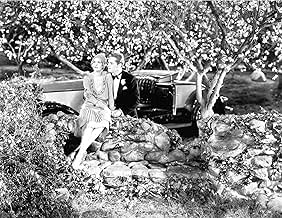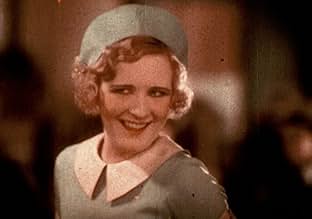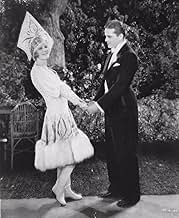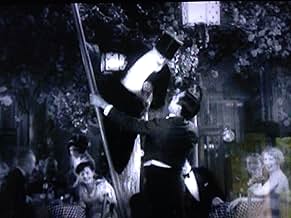Agrega una trama en tu idiomaSally was an orphan who got her name from the telephone exchange where she was abandoned as a baby. In the orphanage, she discovered the joy of dancing. Working as a waitress, she goes from ... Leer todoSally was an orphan who got her name from the telephone exchange where she was abandoned as a baby. In the orphanage, she discovered the joy of dancing. Working as a waitress, she goes from job to job until she finds a job that also allows her to dance. At the restaurant, she mee... Leer todoSally was an orphan who got her name from the telephone exchange where she was abandoned as a baby. In the orphanage, she discovered the joy of dancing. Working as a waitress, she goes from job to job until she finds a job that also allows her to dance. At the restaurant, she meets Blair and they fall for each other, but Blair is engaged to Marcia. Sally is hired to i... Leer todo
- Dirección
- Guionistas
- Elenco
- Nominado a 1 premio Óscar
- 1 premio ganado y 1 nominación en total
- Undetermined Role
- (sin créditos)
- Cafe Customer
- (sin créditos)
- Chorus Girl
- (sin créditos)
- Party Guest
- (sin créditos)
- Cafe Customer
- (sin créditos)
- Girls in dance number
- (sin créditos)
Opiniones destacadas
Supporting her is a very young Joe E Brown (best known as Captain Andy in the third film version of Show Boat) who is a lot of fun, and Alexander Gray, who like many other leading men of the early talkies is a bit of a stuffed shirt. You'll also spot the Keystone Kops' Ford Sterling as 'Pops'.
'Sally' is a hugely enjoyable early talkie. The colour sequence is lovely and bright - it is a pity that we lose the impact from the rest of the film. The songs are good and Miss Miller is a treat to watch. Try to catch this when it next airs on TCM.
In 1929 she made "Sally" for First National (forerunner of Warner Bros.) in which she recreated one of her stage triumphs. It is good and with some competent back-up supporting actors, but I would say it is an incomplete document if one is trying to 'discover' Marilyn Miller. The story is familiar, about a waitress looking for her big show biz break with a romantic side-story, and she shows her star appeal as a passable singer, a better actress and an even better dancer. She is pretty in a familiar sort of way, but she wins you over with her vivacious, cheerful demeanor.
The website rating is about right, and you get the feeling that being captured on film in an unremarkable story doesn't do her justice. I haven't seen her other films but I am reasonably certain that they do not capture the full impact of this legendary performer, either. I guess we'll just have to rely on historical sources and those three films.
The story revolves around Sally Green (Marilyn Miller), a young woman raised in an orphanage now earning a living as a waitress at a crowded New York City restaurant, whose one ambition is to become a dancer. After Sally makes an impression on Otis Hooper (T. Roy Barnes), a theatrical agent dining with Rosie (Pert Kelton - almost unrecognizable as a brunette), she loses her chance as well as her job when she accidentally spills a tray of food all over him. Sally acquires another job waiting on tables at the Elm Tree Inn managed by "Pops" Shendoroff (Ford Sterling), with Connie (Joe E. Brown), formerly Constantine, Grand Duke of Checkercovinia, working as a waiter. Sally soon makes the acquaintance of Blair Farell (Alexander Gray), the son of an aristocratic father (E.J. Ratcliffe) who arranged for him to marry socialite Marcia Ten Brook (Nora Lane). Blair, who had earlier noticed Sally through the window of the restaurant, takes an interest in Sally and arranges to have Schendorff dance for the customers, one of them being Otis Hooper. Hooper later encourages Sally to perform at Mrs. Ten Brook's (Maude Turner Gordon) garden party, which she does, under the guise of Madame Noskerova, the famous Russian dancer, at the same time Connie makes his grand entrance as the Grand Duke. When Schendorf gives away their identities, Mrs. Ten Brook orders Sally to leave, which she does after hearing Blair's announced engagement. Although Sally achieves stardom dancing for the Ziegfeld Follies, she finds she's unable to forget about Blair.
With music and lyrics by B.G. DeSylva, Al Dubin, Joe Burke, Clifford Grey and Jerome Kern, the musical program is as follows: "Look For the Silver Lining" (sung by Alexander Gray and Marilyn Miller); "Sally" (sung by Alexander Gray); "Look For the Silver Lining" "Sally" and "Look For the Silver Lining" (danced by Miller and Joe E. Brown); "If I'm Dreaming, Don't Wake Me Too Soon" (duet by Miller and Gray); "Walking Off These Balkan Blues" (danced by Joe E. Brown); "All I Want to Do Do Do is Dance" (sung by Miller); "Wild Rose" (sung by Miller and male chorus); "If I'm Dreaming, Don't Wake Me Too Soon" (reprise by Miller and Gray); Russian dance number performed by the Albertina Rasch Ballet; and "Broadway Follies" instrumental ballet/ dance numbers (performed by Miller).
With SALLY available in black and white format, only the "Wild Rose" dance sequence survives in its original, yet slightly fuzzy, Technicolor form. The song, "Look for the Silver Lining," most associated with Miller, was used as the title to a Warner Brothers 1949 bio-pic starring June Haver as Marilyn Miller. If the score to "If I'm Dreaming" sounds familiar, it was used for a dance sequence between Douglas Fairbanks Jr. and Glenda Farrell in the gangster classic, LITTLE CAESAR (1930) starring Edward G. Robinson. Alexander Gray, a deep voice baritone, notable for his screen teaming with Bernice Claire in early Warners musicals of 1929-30, is acceptable as the leading man, though wasn't quite the type to survive the movie medium to the next decade. Joe E. Brown, still early in his career before starring in his own comedies, has little opportunity being funny but does provide some highlights, including a comedy dance with Miller, and another as a waiter escorting an old man (Jack Duffy) and his young date (Ethel Stone) up a latter to their table with a view, proving to be troublesome for all.
As for Marilyn Miller, she would follow SALLY with more singing, dancing and romancing with SUNNY (1930) and HER MAJESTY, LOVE (1931) before returning to Broadway. Of the three, SALLY is most acceptable mainly for being a recorded document of her stage play, while SUNNY, another screen adaptation, disappoints for anyone who had seen the stage version to find much of the original score missing from the final print. HER MAJESTY, LOVE, intended to be something original, offered nothing new in the genre of sophisticated director, Ernst Lubitsch.
With so many 1929-30 musicals currently lost or incomplete, SALLY was fortunate to have survived intact at 100 minutes, even without the color. Unavailable for viewing since its initial theatrical release, SALLY made it to television on Turner Classic Movies in August 1994, where this and other Marilyn Miller musicals enjoyed occasional revivals for the next few years. (***)
Produced by Florenz Ziegfeld Jr., the Cinderella-like "Sally" (1920-1922) was a huge Broadway success for Miller. With this show, plus her high-profile 1922 marriage to Hollywood royalty (Mary's brother Jack Pickford), Miller was a big star before she ever made a motion picture. Reportedly, the Pickfords did not get Miller in the movies earlier because they felt her skills were not flattered by the silent movie medium; this is evident. "Sally" (also a re-make of the hit 1925 "silent" version starring Colleen Moore) was a top-line production, in full Technicolor. Gray sounds great as Miller's leading man and Brown is a best supporting actor - even without kissing T. Roy Barnes...
Unless more is found, only a rough black-and-white print of "Sally" survives. The only color portion available has most of Miller's "Wild Rose" dance and a small portion of Mr. Brown's subsequent scene. These brief color minutes indicate the whole work was visually quite appealing. However, the staging and plot are not spectacular. Miller's dancing is a highlight. Probably, she would have been a bigger musical movie star in the 1940s. Her great comic "pas de deux" with Brown makes one long for other Miller dance team-ups. Jerome Kern's music is most memorable. "Look for the Silver Lining" became a #1 million-selling hit song in 1921, and a standard thereafter.
****** Sally (12/23/29) John Francis Dillon ~ Marilyn Miller, Alexander Gray, Joe E. Brown, T. Roy Barnes
This is the second of three films starring Miller, who was a huge star on Broadway in the 1920s as Ziegfeld Follies' lead actress. Miller only lived to be 37.
This film desperately needs to be restored. It could be a pretty good film. Although the story is pedestrian, some of the scenes are funny, although much of the humor is buried in poor sound quality. The film features early Vitaphone audio, which synchronized record albums with film. This can make restoration a particular challenge. The records were fragile and were only meant to be played a few times before they were replaced. If the discs are gone, what's left is whatever dub was made onto film long ago.
¿Sabías que…?
- TriviaOriginally presented in 100% two-color Technicolor, at present the complete film survives only in black and white, with a singular musical number, "Wild Rose," in color.
- Citas
Otis Hooper: [to 'Connie', the waiter] I have 10 bucks - and only 10 bucks.
[opens the menu]
Otis Hooper: What would you suggest?
'Connie': Another restaurant.
- ConexionesFeatured in Broadway: The American Musical (2004)
- Bandas sonorasSally
(1920) (uncredited)
Music by Jerome Kern
Lyrics by Clifford Grey
Played during the opening credits and often in the score
Sung by Alexander Gray and Chorus
Danced by Marilyn Miller and Joe E. Brown
Danced by Miller and Albertina Rasch Dancers at the follies
Selecciones populares
Detalles
Taquilla
- Presupuesto
- USD 647,000 (estimado)
- Tiempo de ejecución1 hora 43 minutos
Contribuir a esta página



